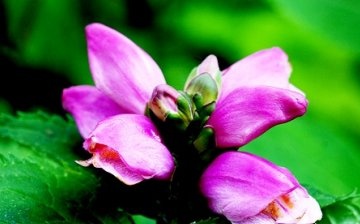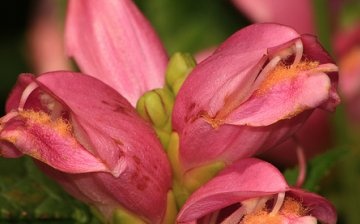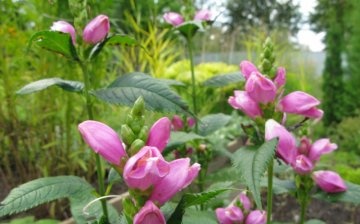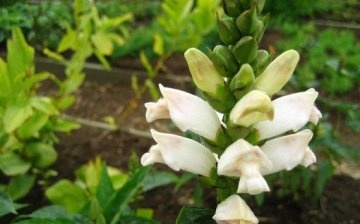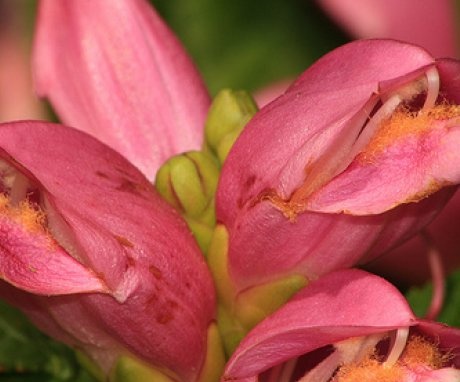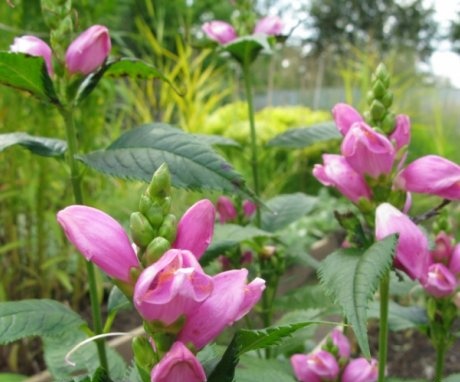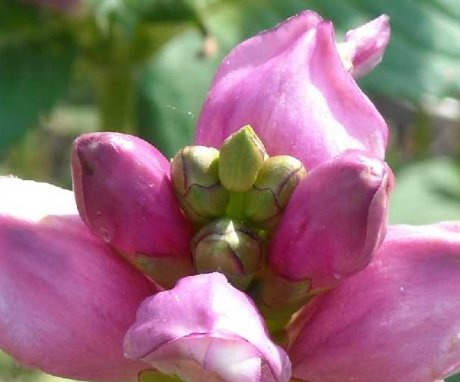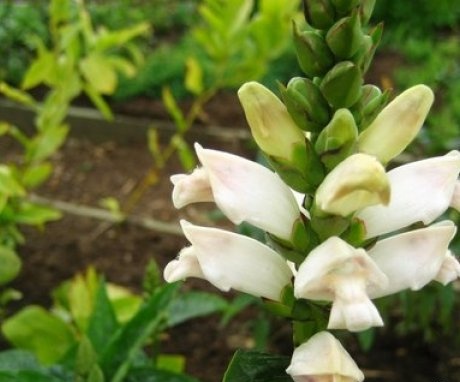Growing Helone - everything a gardener needs to know
An ornamental perennial plant, which came to us from distant America, will decorate even the most ordinary-looking garden. The unpretentiousness of the beauty, unusual for warm regions, provided us with the opportunity to grow perennial in a rather harsh climate. The beauty of the inflorescences and the juicy, carved greenery requires a more detailed examination of this, rare in our gardens, foreign guest. Is it possible to grow an exotic plant in harsh conditions - the answer can be found in this short, useful gardener's encyclopedia.
Content:
- Helone: botanical descriptions and species
- Reproduction of perennial
- Chelone care, tips and nuances
- Possible diseases and pests
Helone: botanical descriptions and species
Helone is a perennial plant belonging to the Norich family. The homeland of the overseas miracle is the northern part of America. There is also other information. According to some sources, it can also be found in the southeastern part of the country. It grows in shady and humid places, usually near water bodies, rivers and ponds. Feels great both in the shade and in the sun.
Among the people, the beauty has already received its name - a long-term snapdragon.
The reason was the external similarity of plants. Period flowering perennial depends on its variety. Most of the flowering period begins in August and ends in late autumn. Some species bloom in July.
Perennial description:
- The height of the shrubs can reach 1 m or more, depending on the species.
- Helone greens are unusual - they are juicy, dark green leaves with carvings along the edges. Strong erect stems rush up from them.
- The color palette of inflorescences ranges from white, pale pink, reddish to deep crimson. Almost all flowers are decorated with a bright yellowish spot.
- During flowering all branches are covered with buds that open in a cascade from bottom to top.
- The plant looks impressive without flowering. Shiny greenery and luscious carved leaves decorate the general background of the garden, other early flowers look favorably against the contrast of the dark greenery of the chelone.
Helone is divided into several types. In our area, it is customary to grow:
- More often, gardeners prefer to plant a species - oblique chelone. Plant height reaches 70-80 cm. Luscious greenery is decorated with pinkish, lilac or white large flowers. The leaves are carved with pronounced veins. Inflorescences are grouped at the tops of the shoots.
- Helone glabrous is a perennial plant reaching 1.5 m in length. Paired, thick, dark green leaves adorn the upward-streaming stems. The species is characterized by white-pink flowers of an impressive size for this plant - up to 3 cm.
- The green-flowered species reaches a length of 2 m. The colors of this plant deserve special attention - the yellowish tint of the inflorescence is crowned with a "hood". Chloranta looks very impressive. The plant is recommended to be planted along partitions, in a shady part of the garden.
- Helone Lyona is a medium-sized perennial bushreaching 50-70 cm in length. The colors of the inflorescences are distinguished by rich shades of pink - from pale to deep red. The greenery of the plant is characterized by a low planting of oval-shaped leaves.The stems are small, inflorescences are formed on the lateral branches.
Reproduction of perennial
The unpretentiousness of the overseas guest allows him to land him in any land. It thrives on both moderately clayey and fertile soils. It is preferable to plant the plant in a prepared fertile soil, so it will develop faster. Many gardeners claim that exotic loves acidic environments, flavored with humus.
The main condition for growing is the abundant moisture in the fertile layer.
An excellent solution would be to plant a chelone in a shady part of the garden near a small pondif available. You can place the plant in a common flower garden on the sunny side. In this case, you will have to constantly monitor the soil moisture, the chelone does not tolerate drought. Many gardeners plant a curiosity along fences and flower beds, thereby constructing a picturesque backdrop for other ornamental plants of a lower height.
Plant propagation occurs in several ways:
Any method of disembarkation involves mulching soil. This stage is especially important when the plant propagates by the rhizome. Disembarkation seed occurs either in the fall or in the spring. Gardeners praise the plant for the friendly seedlings of sowing. This fact does not depend on the soil in which the seeds are planted. Sometimes the climate of the region affects the ability of a plant to ripen seeds in a timely manner. It can also happen with young chelone bushes.
Reproduction in a vegetative way - by dividing the rhizome:
- This is done in the spring bush is dug up and divided into parts.
- The resulting "delenki" are planted in fertile soil in a new place.
- It is necessary to constantly monitor the level of soil moisture. It shouldn't dry out.
If you decide to propagate the plant with cuttings, the work will differ only in the later disembarkation to a permanent place. First, the stalk is planted in a nursery. In the fall, a plant that has taken root transplanted to a permanent place. Helone takes root well, there are no problems with transplantation. The seedling is unpretentious, but it is necessary to maintain soil moisture.
Gardeners often propagate perennials using seedlings.
Seeds are sown on seedlings in late March. Young seedlings are recommended to be planted in open ground in the month of June. According to gardeners, this planting method contributes to faster flowering... The plant begins to delight with its beauty as early as 2 years of age. Some varieties are capable of flowering in the first year. True, the bush will be small - 40-50 cm in height. Flowers will appear on only one of the shoots. However, propagation with seedlings is considered to be the most effective.
Chelone care, tips and nuances
The overseas wonder must be fertilized 3 times during the entire growing season. They feed him with complex mineral fertilizers:
- The first serving of nutrients is given in March.
- The second is in the second half of May.
- The third is just before flowering.
Throughout the growing season, it is necessary to monitor soil moisture. Shoots are pruned in late autumn. Shoots should be a maximum of 10 cm above the ground. Helone is considered a godsend for gardeners. This is due to its ability to winter without shelter at very low temperatures. The cut off shoots are left in the winter.
The only thing to do is lay the winter mulch. The optimal composition will be peat and humus from the leaves. The thickness of the mulch will be 5-10 cm. This completes the preparation of the plant for winter. It is not recommended to cover the perennial for the winter. It gets along well with our harsh winter.
Weeding the plant is required.
It prevents the appearance weeds due to its rhizome and dense arrangement of greenery - stems and leaves at the base. This plant advantage is very popular with gardeners. One less problem. Multiply bushes can be used during the flowering period.Before planting the rhizome in a new place, be sure to treat the soil with summer mulch.
Possible diseases and pests
Perennial have not yet acquired a sufficient number of diseases and pestsso that you can worry about its safety. In a rainy period, due to excessive humidity, slugs can start in the depths of the flower bed. But they are not able to significantly damage the rhizome. Therefore, gardeners do not recommend sounding the alarm when they appear. The plant can be affected by "rust". This happens very rarely.
In case of a disease, the plant is treated with Bordeaux liquid.
It is advisable to carry out the treatment before flowering... As a preventive measure, it is necessary to loosen the soil, allowing it to ventilate. Otherwise, it does not cause much trouble.
It is very easy to grow a perennial wonder in our area. Planted along the banks of reservoirs or ponds, it will delight with luscious greenery and late flowering, when all the other usual flowers have already fallen off. Simple care and cultivation, beauty and grace make helone a unique decorative element of any garden.
More information can be found in the video.



